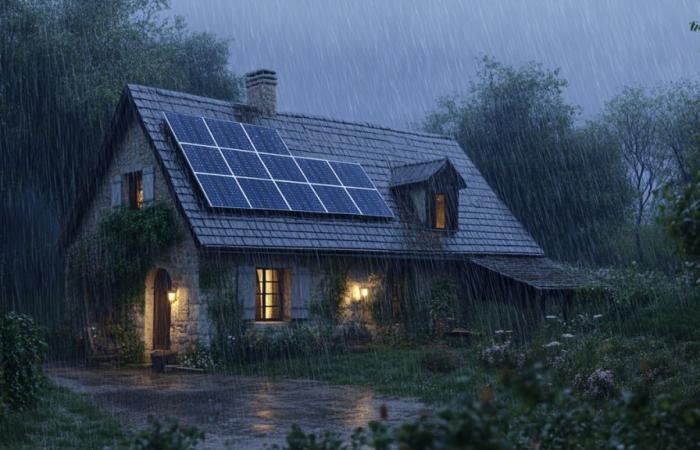A major breakthrough is looming: a new type of solar panel that works with raindrops. In France, it is common to say that this should suit the inhabitants of Brittany, one of the regions of France where it rains the most.
It’s a commonplace in France and for many French people: in Brittany, it rains. Although this is not true all the time, the main cities of the North-West region of France are regularly among the wettest places in France.
And everyone agrees that if it rains, there is no sun. What about the use of solar panels then?
Well, Chinese scientists are currently on the subject and working on a new type of solar panel that would work in the sun and in rainy weather.
Although this technology is still in its infancy and a commercial application is still far away, the innovation promises to have major impacts in the field of renewable energy.
In effect, this means that the power supply would no longer be dependent on the direct availability of solar rays, thus providing a solution to interruptions in energy production.
An innovation that uses both rain and sun
Solar energy has seen massive adoption across the world, becoming one of the most economical sources of energy. This is due to a combination of technological advances and a continued decline in production costs, which have fallen by 10% in recent years. However, even with the best solar panels, energy production stops when the sun disappears behind the clouds or sets.
It is in this context that the project of the University of Soochow, in China, takes on its full meaning. This initiative is based on the use of a physical phenomenon, the triboelectric effect (the famous static electricity), to exploit the energy of raindrops, a phenomenon previously unexploited in traditional solar systems.
The principle of the triboelectric effect: generating energy from rain
The triboelectric effect refers to the production of an electric charge by the friction of two different materials. Soochow engineers have succeeded in combining this approach with a conventional solar cell by developing a hybrid system that integrates a triboelectric nanogenerator, or TENG (Triboelectric Nanogenerator). This device takes advantage of the movement of raindrops on the surface of the panel to generate additional electricity.
The concept developed at Soochow involves placing two thin layers of transparent polymer on an inclined photovoltaic cell. When raindrops hit the surface, they generate a static electrical charge, extending the panel’s ability to produce power even in the absence of direct sunlight.
An innovative design with many potential applications
Baoquan Sun, one of the researchers behind this innovation, specified that the device developed is particularly light. According to him, this technology could find applications in mobile and flexible devices, such as smart clothing or portable electronic equipment.
« Thanks to our unique design, we obtain a lightweight device. In the future, we plan to integrate it into mobile and flexible devices, such as electronic clothing. However, the output power efficiency still needs to be improved before it can be applied in practice. » Baoquan Sun
However, Sun admits that improvements are still needed, particularly in energy production efficiency, before this technology can be used on a large scale.
However, Sun is optimistic about the future of this project. He estimates that a commercial prototype could emerge within three to five years, thanks to the rapid evolution of technologies in the field of renewable energy.
Shared opinions from solar sector experts
While this new technology is generating a lot of interest, it is also the subject of debate within the scientific community. Varun Sivaram, a solar energy expert at the Council on Foreign Relations in the United States and author of a reference book on solar energy, sees the idea of a hybrid device harvesting the kinetic energy of raindrops as a promising concept. He particularly salutes the technical ingenuity of the project, emphasizing:
“There are many fascinating innovations in this approach, including the use of a single dual-function layer, which serves as both a component of the TENG and a light trap for the solar cell. »
However, Sivaram points out that the amount of energy currently generated by rain is insufficient to have a significant impact on overall production. According to him, it is still uncertain whether this technology can truly revolutionize the solar energy sector in the short term.
Professor Keith Barnham, of Imperial College London, shares a similar view. While recognizing that the Chinese system is more compact and potentially more efficient, he believes that triboelectric energy is not necessarily the most suitable solution:
“Wind power is by far the most efficient and complementary source to photovoltaics – and it also works very well in the rain. »
Towards concrete applications of triboelectric nanogenerators (TENG)
Although TENGs have not yet aroused the enthusiasm of solar experts due to their low efficiency, they offer interesting prospects in other areas. These devices, which generate electricity from the friction of two materials, could be used in environments where small amounts of energy are sufficient.
For example, they could be integrated into touchscreens, where the simple movement of fingers on the screen could charge the battery. Additionally, vibrations produced by cars on roads or pedestrian footsteps could also be converted into electrical energy. So, although the technology is still developing, it opens the way to many practical applications that could transform various sectors.
A promising technology, but still in progress
While the innovation developed at Soochow University is undeniably promising, it still needs to overcome several challenges before establishing itself as a viable solution in the field of renewable energy. Producing electricity from raindrops, although attractive, still requires significant progress in efficiency.
However, as with many scientific innovations, it is possible that this technology will take an unforeseen direction and reveal itself in a more practical form in the years to come. Either way, the idea of solar panels working even in bad weather opens up exciting new possibilities for the future of clean energy.
Our buying guides to properly equip your home
Are you lost when faced with the multitude of products to equip your home? Don’t panic, the editorial team is here to guide you! Whether you are looking for a surveillance camera to protect your home, a robot vacuum cleaner for an impeccable household or an oil-free fryer for healthy and delicious meals, our complete buying guides will accompany you step by step. not. Our mission? Provide you with all the information necessary to make an informed choice adapted to your needs.






